

Experts Recommend Automation for a Healthier Lifestyle
Wed, 20 Oct 2021 19:59:25 -0000
|Read Time: 0 minutes
Like any good techie, I can get a little obsessed with gadgets that improve my quality of life. Take, for example, my recent discovery of wearable technology that eases the symptoms of motion sickness. For most of my life, I’ve had to take over-the-counter or prescription medicine when boating, flying, and going on road trips. Then, I stumbled across a device that I could wear around my wrist that promised to solve the problem without the side effects. Hesitantly, I bought the device and asked a friend to drive like a maniac around town while I sat in the back seat. It actually worked – no headache, no nausea, and no grogginess from meds! Needless to say, I never leave home without my trusty gizmo to keep motion sickness at bay.

Throughout my career in managing IT infrastructure, stress has affected my quality of life almost as much as motion sickness. There is one responsibility that has always caused more angst than anything else: lifecycle management (LCM). To narrow that down a bit, I’m specifically talking about patching and updating IT systems under my control. I have sometimes been derelict in my duties because of annoying manual steps that distract me from working on the fun, highly visible projects. It’s these manual steps that can cause the dreaded DU/DL (data unavailable or data loss) to rear its ugly head. Can you say insomnia?
Innovative technology to the rescue once again! While creating a demo video last year for our Dell EMC OpenManage Integration with Microsoft Windows Admin Center (OMIMSWAC), I was blown away by how easy we made the BIOS, firmware, and driver updates on clusters. The video did a pretty good job of showing the power of the Cluster-Aware Updating (CAU) feature, but it didn’t go far enough. I needed to quantify its full potential to change an IT profressional’s life by pitting an OMIMSWAC’s automated, CAU approach against a manual, node-based approach. I captured the results of the bake off in Dell EMC HCI Solutions for Microsoft Windows Server: Lifecycle Management Approach Comparison.
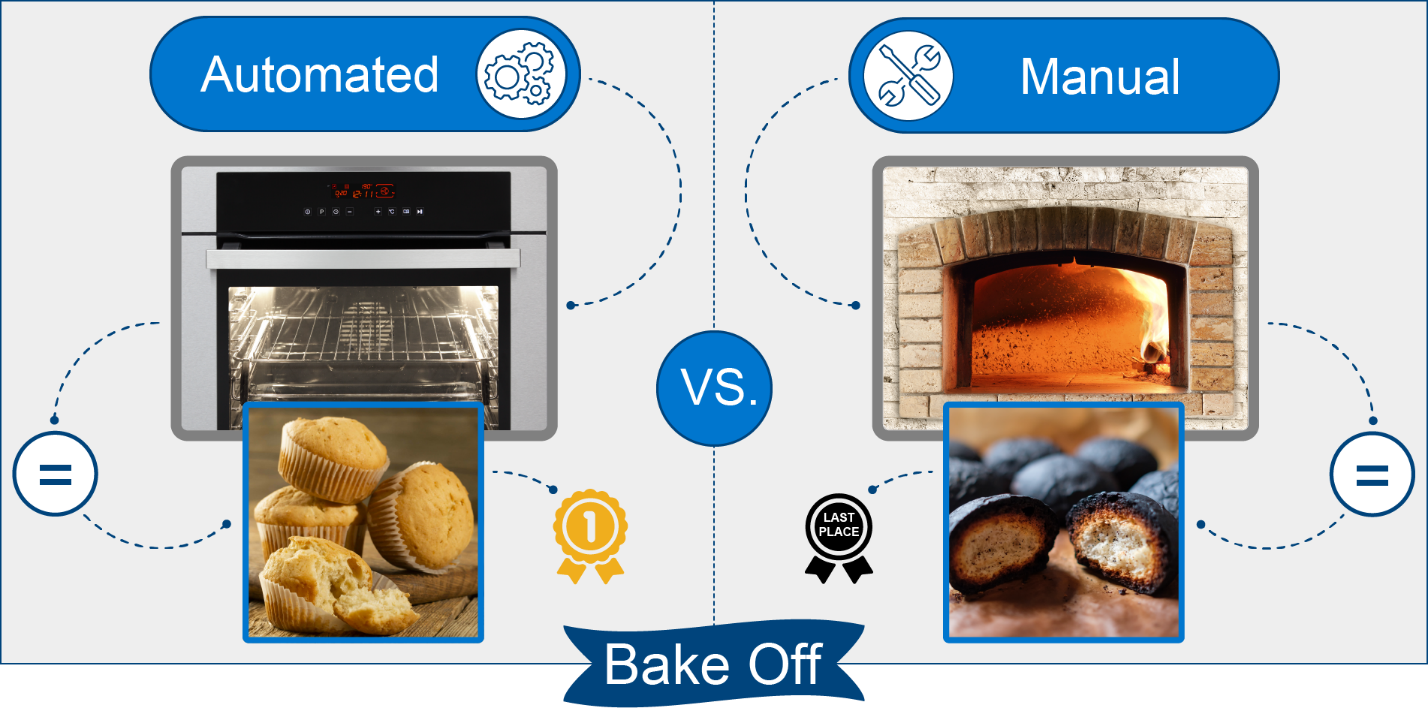
Automation Triumphs!
For this white paper to really stand the test of time, I knew I needed to be very clever to compare apples-to-apples. First, I referred to HCI Operations Guide—Managing and Monitoring the Solution Infrastructure Life Cycle, which detailed the hardware updating procedures for both the CAU and node-based approaches. Then, I built a 4-node Dell EMC HCI Solutions for Windows Server 2019 cluster, performed both update scenarios, and recorded the task durations. We all know that automation is king, but I didn’t expect the final tally to be quite this good:
- The automated approach reduced the number of steps in the process by 82%.
- The automated approach required 90% less of my focused attention. In other words, I was able to attend to other duties while the updates were installing.
- If I was in a production environment, the maintenance window approved by the change control board would have been cut in half.
- The automated process left almost no opportunity for human error.
As you can see from the following charts taken from the paper, these numbers only improved as I extrapolated them out to the maximum Windows Server HCI cluster size of 16 nodes.
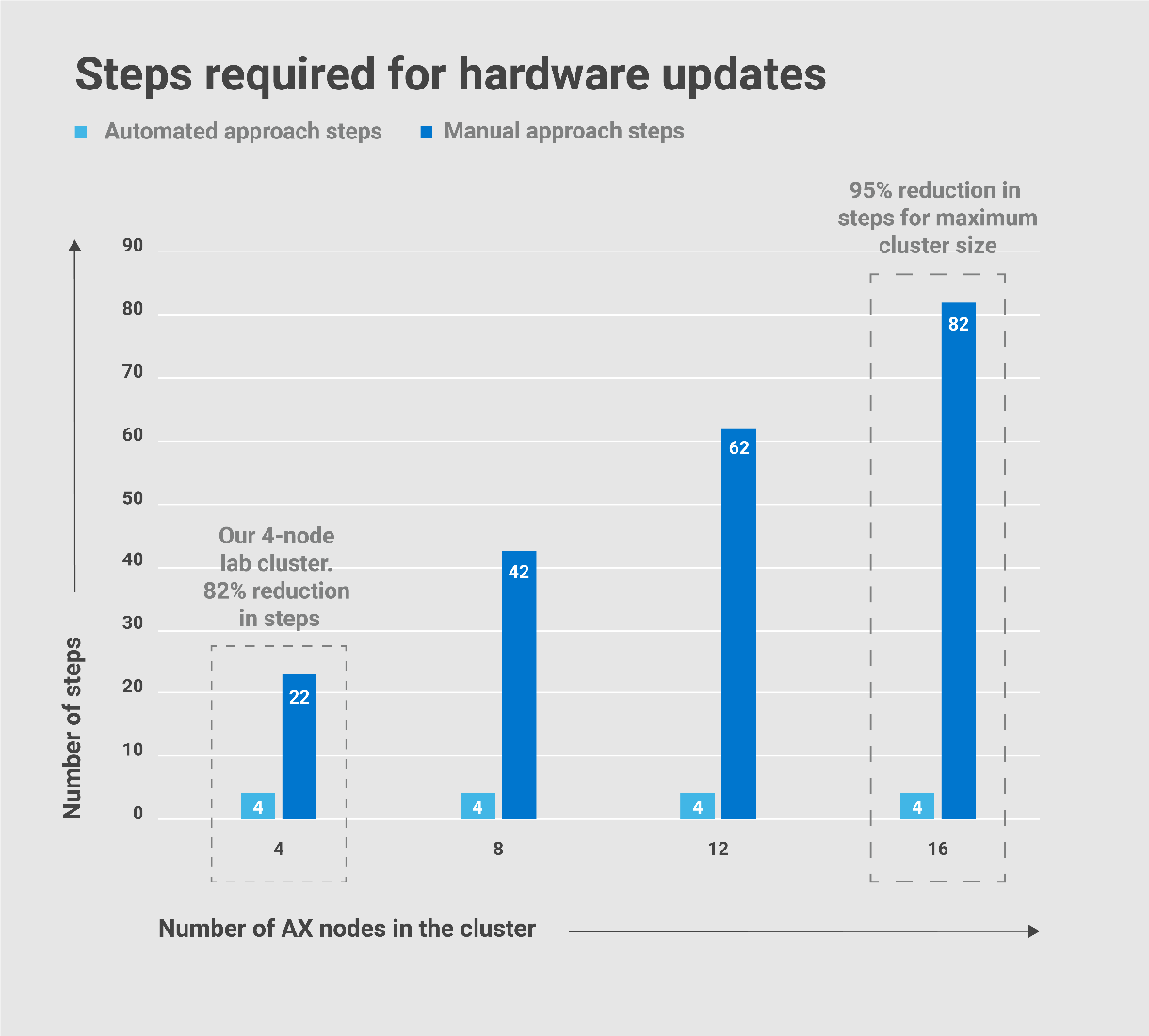
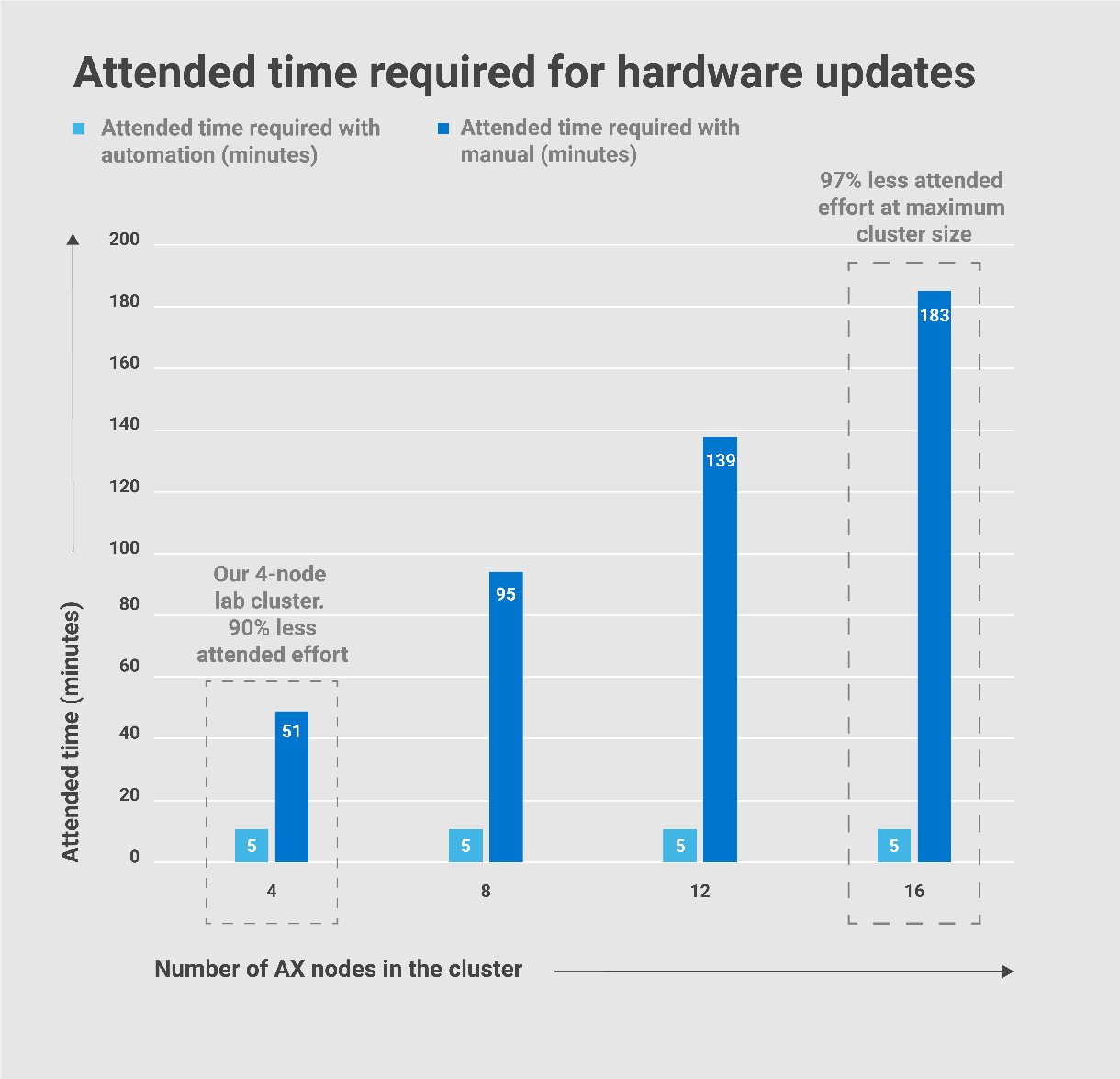
I thought these results were too good to be true, so I checked my steps about 10 times. In fact, I even debated with my Marketing and Product Management counterparts about sharing these claims with the public! I could hear our customers saying, “Oh, yeah, right! These are just marketecture hero numbers.” But in this case, I collected the hard data myself. I am still confident that these results will stand up to any scrutiny. This is reality – not dreamland!
Just when I thought it couldn’t get any better
So why am I blogging about a project I did last year? Just when I thought the testing results in the white paper couldn’t possibly get any better, Dell EMC Integrated System for Microsoft Azure Stack HCI came along. Azure Stack HCI is Microsoft’s purpose-built operating system delivered as an Azure service. The current release when writing this blog was Azure Stack HCI, version 20H2. Our Solution Brief provides a great overview of our all-in-one validated HCI system, which delivers efficient operations, flexible consumption models, and end-to-end enterprise support and services. But what I’m most excited about are two lifecycle management enhancements – 1-click full stack LCM and Kernel Soft Reboot – that will put an end to the old adage, “If it looks too good to be true, it probably is.”
Let’s invite OS updates to the party
OMIMSWAC was at version 1.1 when I did my testing last year. In that version, the CAU feature focused on the hardware – BIOS, firmware, and drivers. In OMIMSWAC v2.0, we developed an exclusive snap-in to Microsoft’s Failover Cluster Tool Extension to create 1-click full stack LCM. Only available for clusters running Azure Stack HCI, a simple workflow in Windows Admin Center automates not only the hardware updates – but also the operating system updates. How do I see this feature lowering my blood pressure?
- Applying the OS and hardware updates can typically require multiple server reboots. With 1-click full stack LCM, reboots are delayed until all updates are installed. A single reboot per node in the cluster results in greater time savings and shorter maintenance windows.
- I won’t have to use multiple tools to patch different aspects of my infrastructure. The more I can consolidate the number of management tools in my environment, the better.
- A simple, guided workflow that tightly integrates the Microsoft extension and OMIMSWAC snap-in ensures that I won’t miss any steps and provides one view to monitor update progress.
- The OMIMSWAC snap-in provides necessary node validation at the beginning of the hardware updates phase of the workflow. These checks verify that my cluster is running validated AX nodes from Dell Technologies and that all the nodes are homogeneous. This gives me peace of mind knowing that my updates will be applied successfully. I can also rest assured that there will be no interruption to the workloads running in my VMs and containers since this feature leverages CAU.
- The hardware updates leverage the Microsoft HCI solution catalog from Dell Technologies. Each BIOS, firmware, and driver in this catalog is validated by our engineering team to optimize the Azure Stack HCI experience.
The following screen shots were taken from the full stack CAU workflow. The first step indicates which OS updates are available for the cluster nodes.
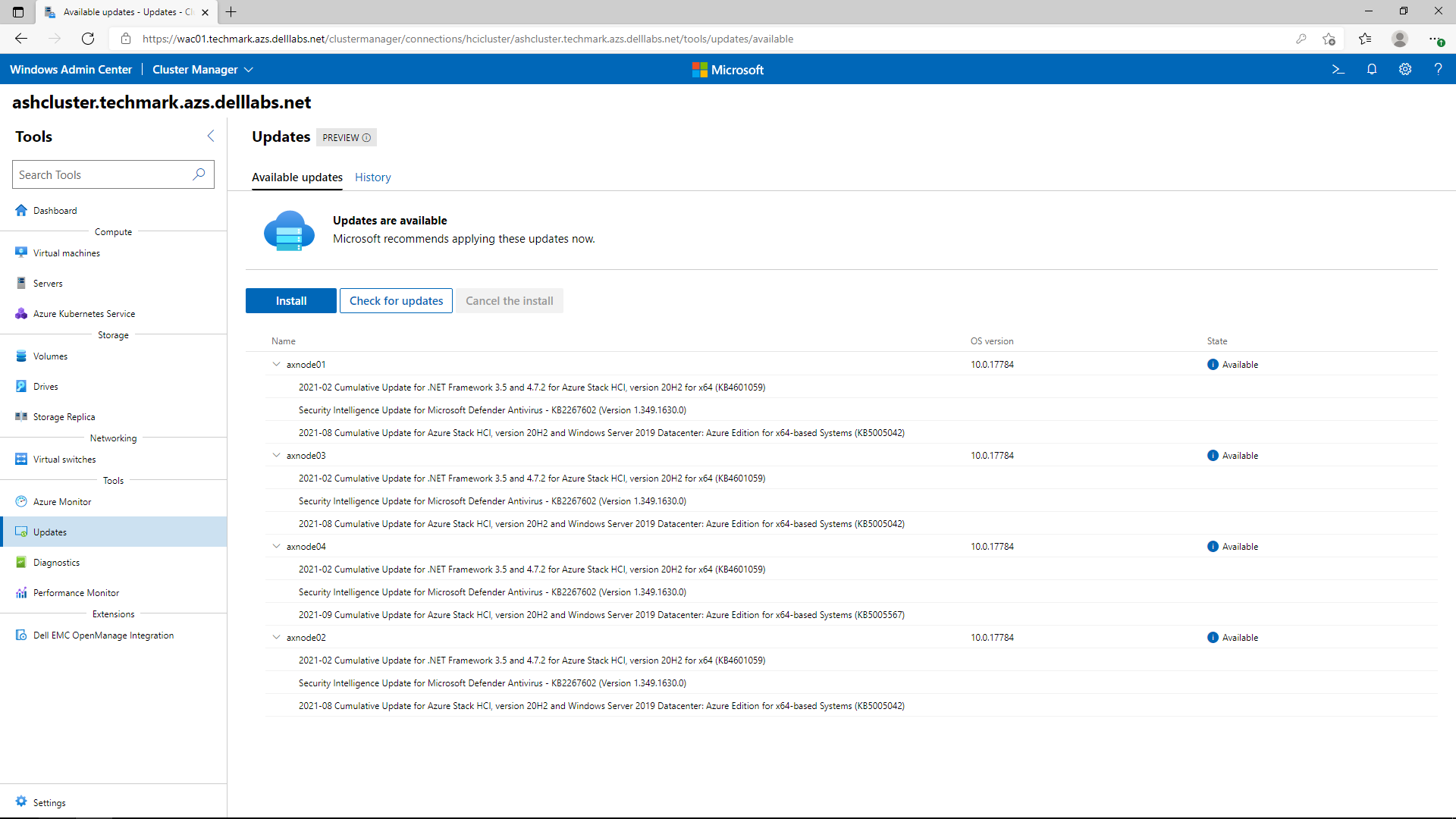
Node validation is performed first before moving forward with hardware updates.
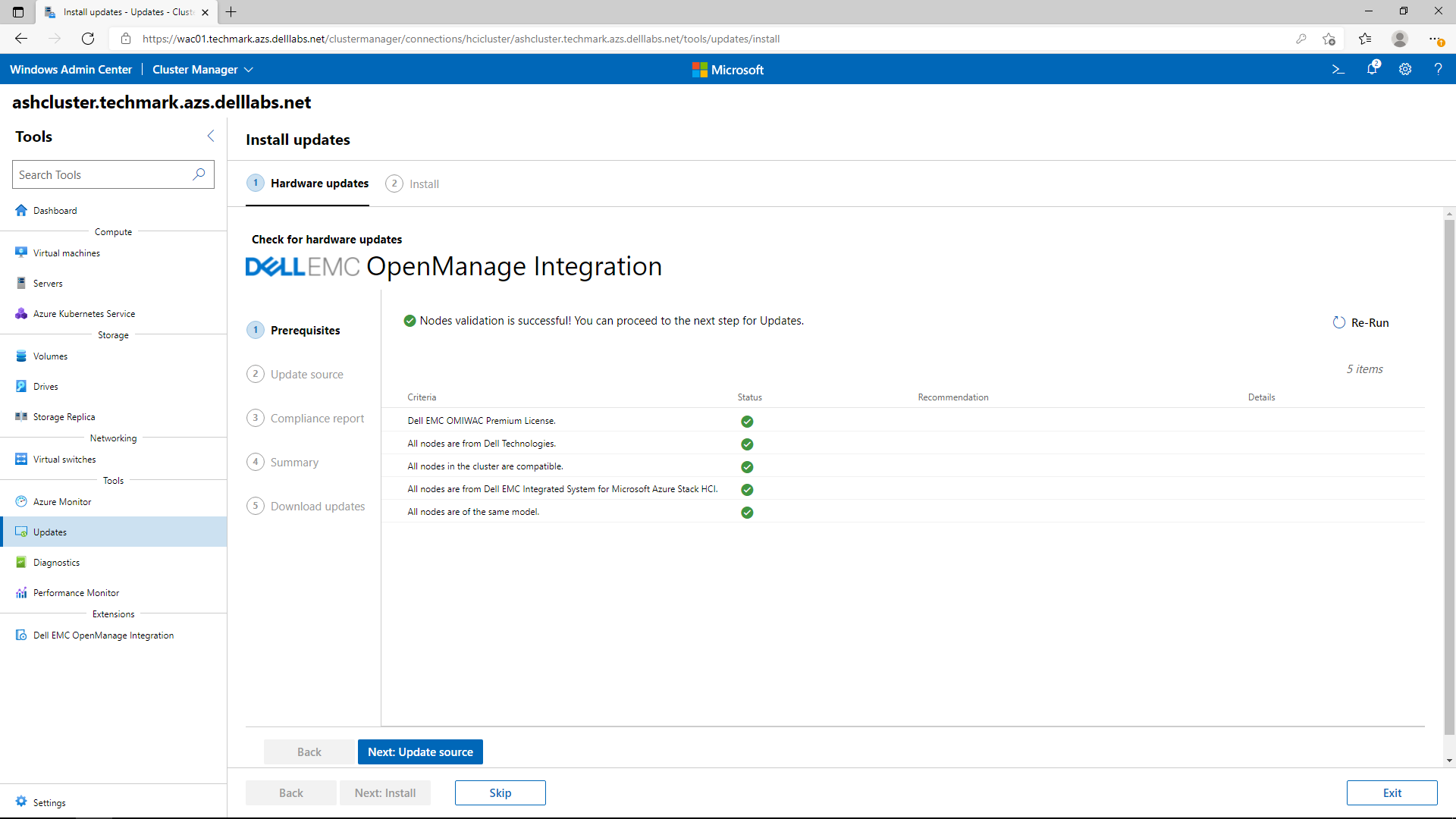
If the Windows Admin Center host is connected to the Internet, the online update source approach obtains all the systems management utilities and the engineering validated solution catalog automatically. If operating in an edge or disconnected environment, the solution catalog can be created with Dell EMC Repository Manager and placed on a file server share accessible from the cluster nodes.
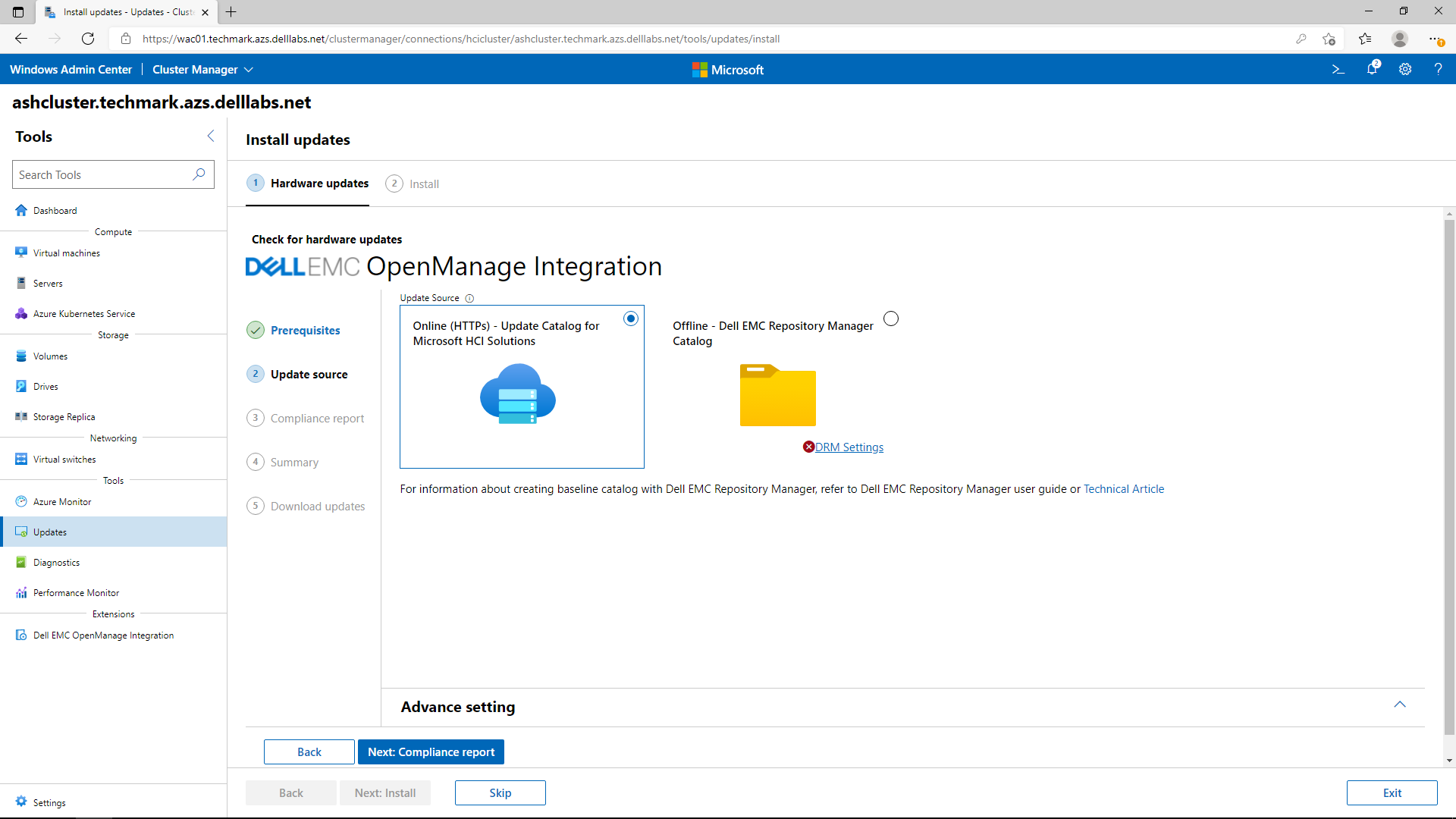
The following image shows a generated compliance report. All non-compliant components are selected by default for updating. After this point, all the OS and non-compliant hardware components will be updated together with only a single reboot per node in the cluster and with no impact to running workloads.
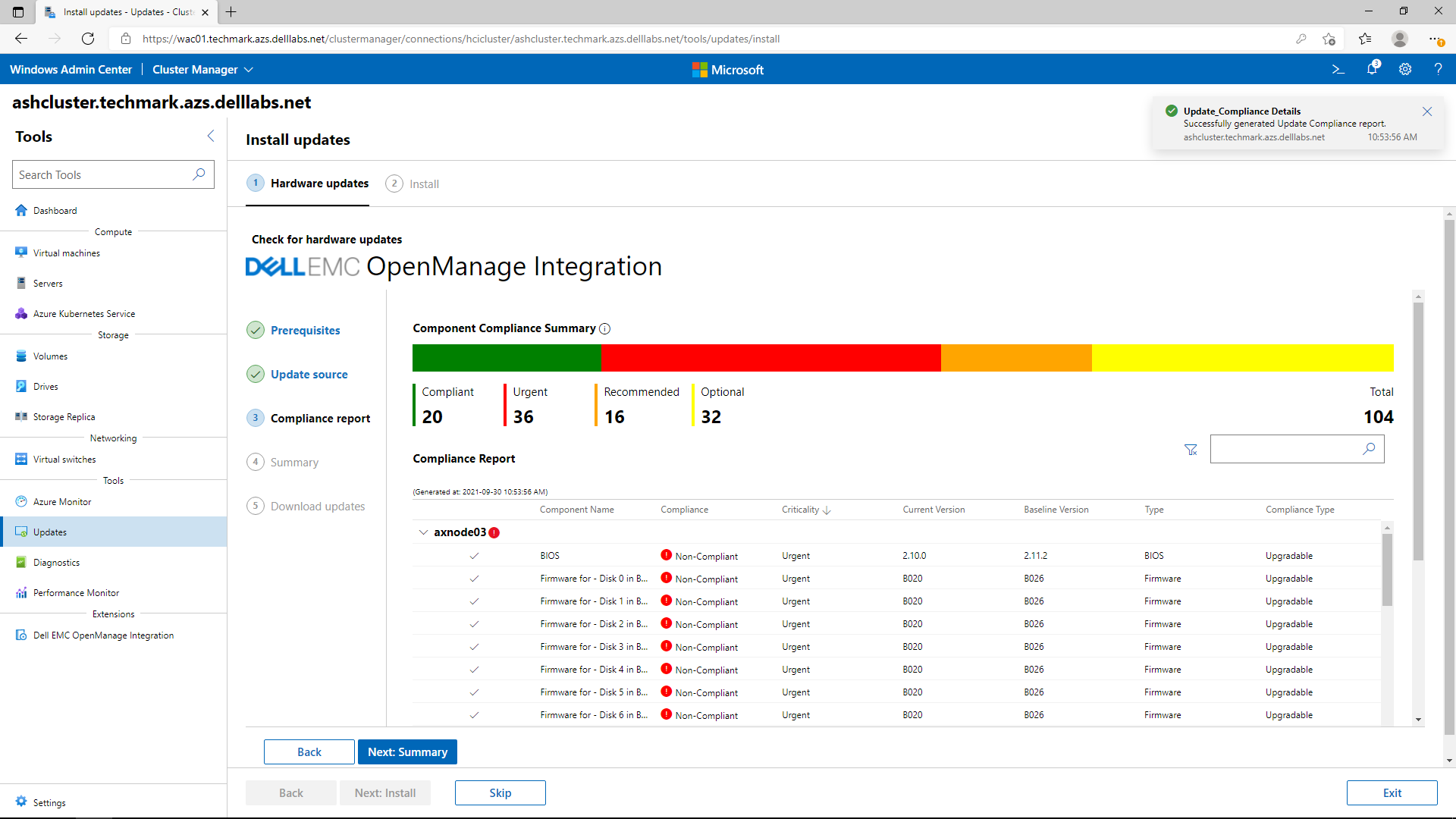
Life is too short to wait for server reboots
Speaking of reboots, Kernel Soft Reboot (KSR) is a new feature coming in Azure Stack HCI, version 21H2 that also has the potential to make my white paper claims even more jaw dropping. KSR will give me the ability to perform a “software-only restart” on my servers – sparing me from watching the paint dry during those long physical server reboots. Initially, the types of updates in scope will be OS quality and security hotfixes since these don’t require BIOS/firmware initialization. Dell Technologies is also working on leveraging KSR for the infrastructure updates in a future release of OMIMSWAC.
KSR will be especially beneficial when using Microsoft’s CAU extension in Windows Admin Center. The overall time savings using KSR multiplies for clusters because faster restarts means less resyncing of data after CAU resumes each cluster node. Each node should reboot with Mach Speed if there are only Azure Stack HCI OS hotfixes and Dell EMC Integrated System infrastructure updates that do not require the full reboot. I will definitely be hounding my Product Managers and Engineering team to deliver KSR for infrastructure updates in our OMIMSWAC extension ASAP.
Bake off rematch
I decided to hold off on doing a new bakeoff until Azure Stack HCI, version 21H2 is released with KSR. I also want to wait until we bring the benefits of KSR to OMIMSWAC for infrastructure updates. The combination of OMIMSWAC 1-click full stack CAU and KSR will continue to make OMIMSWAC unbeatable for seamless lifecycle management. This means better outcomes for our organizations, improved blood pressure and quality of life for IT pros, and more motion-sickness-free adventure vacations. I’m also looking forward to spending more time learning exciting new technologies and less time with routine administrative tasks.
If you’d like to get hands-on with all the different features in OMIMSWAC, check out the Interactive Demo in Dell Technologies Demo Center. Also, check out my other white papers, blogs, and videos in the Dell Technologies Info Hub.
Related Blog Posts

Dell Hybrid Management: Azure Policies for HCI Compliance and Remediation
Mon, 30 May 2022 17:05:47 -0000
|Read Time: 0 minutes
Dell Hybrid Management: Azure Policies for HCI Compliance and Remediation
Companies that take an “Azure hybrid first” strategy are making a wise and future-proof decision by consolidating the advantages of both worlds—public and private—into a single entity.
Sounds like the perfect plan, but a key consideration for these environments to work together seamlessly is true hybrid configuration consistency.
A major challenge in the past was having the same level of configuration rules concurrently in Azure and on-premises. This required different tools and a lot of costly manual interventions (subject to human error) that resulted, usually, in potential risks caused by configuration drift.
But those days are over.
We are happy to introduce Dell HCI Configuration Profile (HCP) Policies for Azure, a revolutionary and crucial differentiator for Azure hybrid configuration compliance.
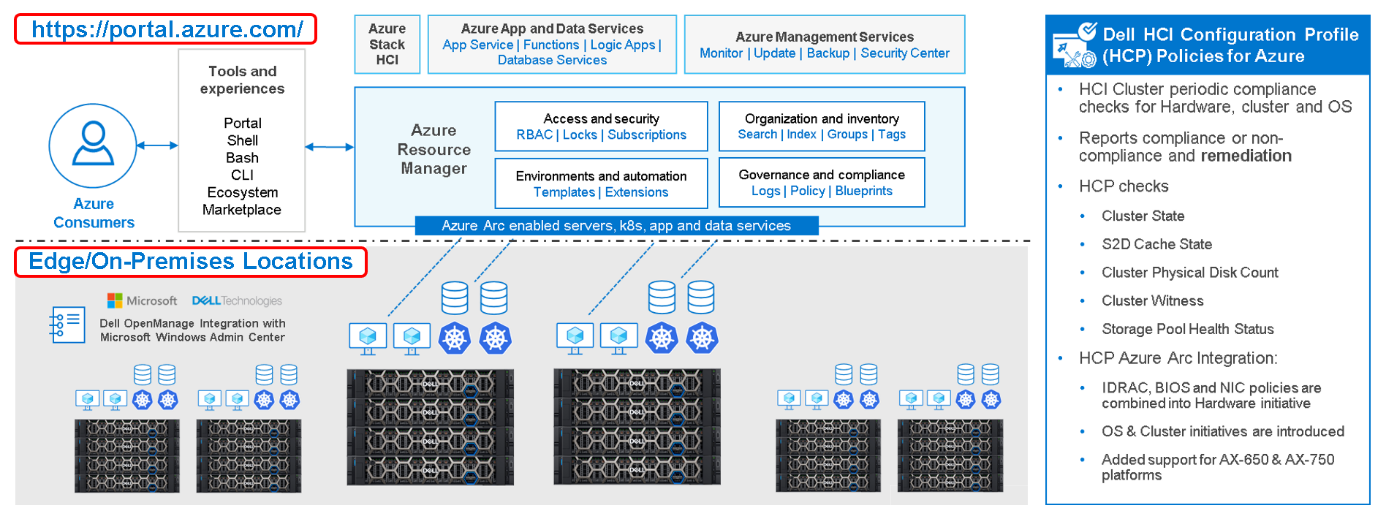
Figure 1: Dell Hybrid Management with Windows Admin Center (local) and Azure/Azure Arc (public)
So, what is it? How does it work? What value does it provide?
Dell HCP Policies for Azure is our latest development for Dell OpenManage Integration with Windows Admin Center (OMIMSWAC). With it, we can now integrate Dell HCP policy definitions into Azure Policy. Dell HCP is the specification that captures the best practices and recommended configurations for Azure Stack HCI and Windows-based HCI solutions from Dell to achieve better resiliency and performance with Dell HCI solutions.
The HCP Policies feature functions at the cluster level and is supported for clusters that are running Azure Stack HCI OS (21H2) and pre-enabled for Windows Server 2022 clusters.
IT admins can manage Azure Stack HCI environments through two different approaches:
- At-scale through the Azure portal using the Azure Arc portfolio of technologies
- Locally on-premises using Windows Admin Center
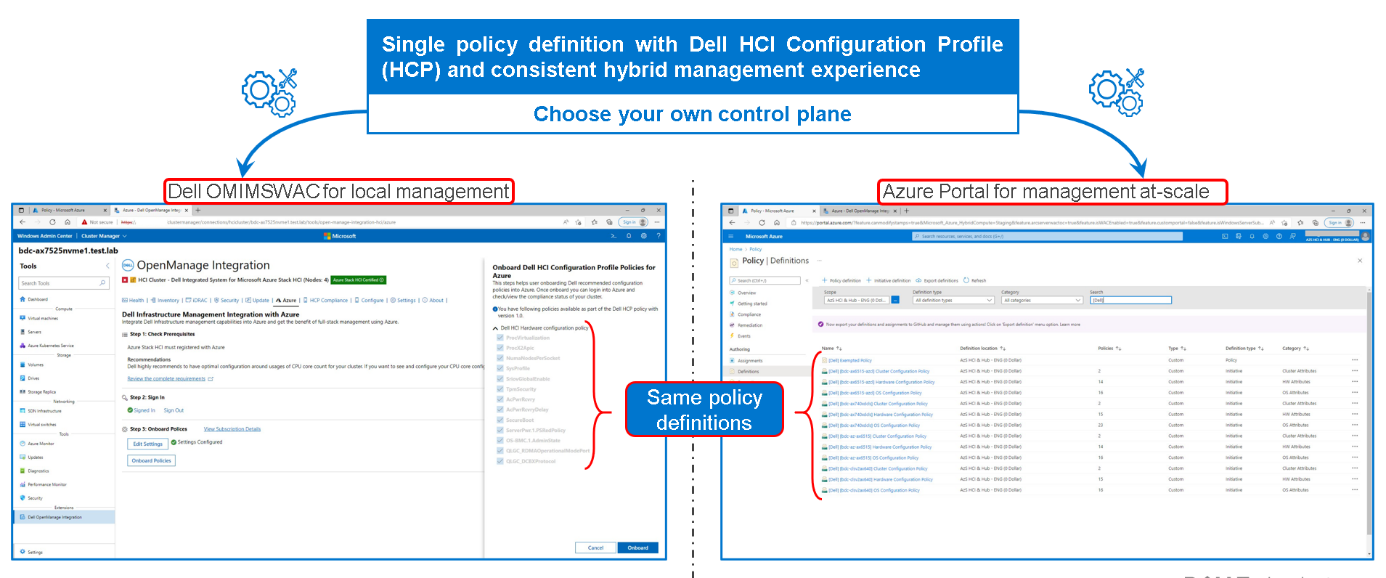
Figure 2: Dell HCP Policies for Azure - onboarding Dell HCI Configuration Profile
By using a single Dell HCP policy definition, both options provide a seamless and consistent management experience.
Running Check Compliance automatically compares the recommended rules packaged together in the Dell HCP policy definitions with the settings on the running integrated system. These rules include configurations that address the hardware, cluster symmetry, cluster operations, and security.

Figure 3: Dell HCP Policies for Azure - HCP policy compliance
Dell HCP Policy Summary provides the compliance status of four policy categories:
- Dell Infrastructure Lock Policy - Indicates enhanced security compliance to protect against unintentional changes to infrastructure
- Dell Hardware Configuration Policy - Indicates compliance with Dell recommended BIOS, iDRAC, firmware, and driver settings that improve cluster resiliency and performance
- Dell Hardware Symmetry Policy - Indicates compliance with integrated-system validated components on the support matrix and best practices recommended by Dell and Microsoft
- Dell OS Configuration Policy - Indicates compliance with Dell recommended operating system and cluster configurations
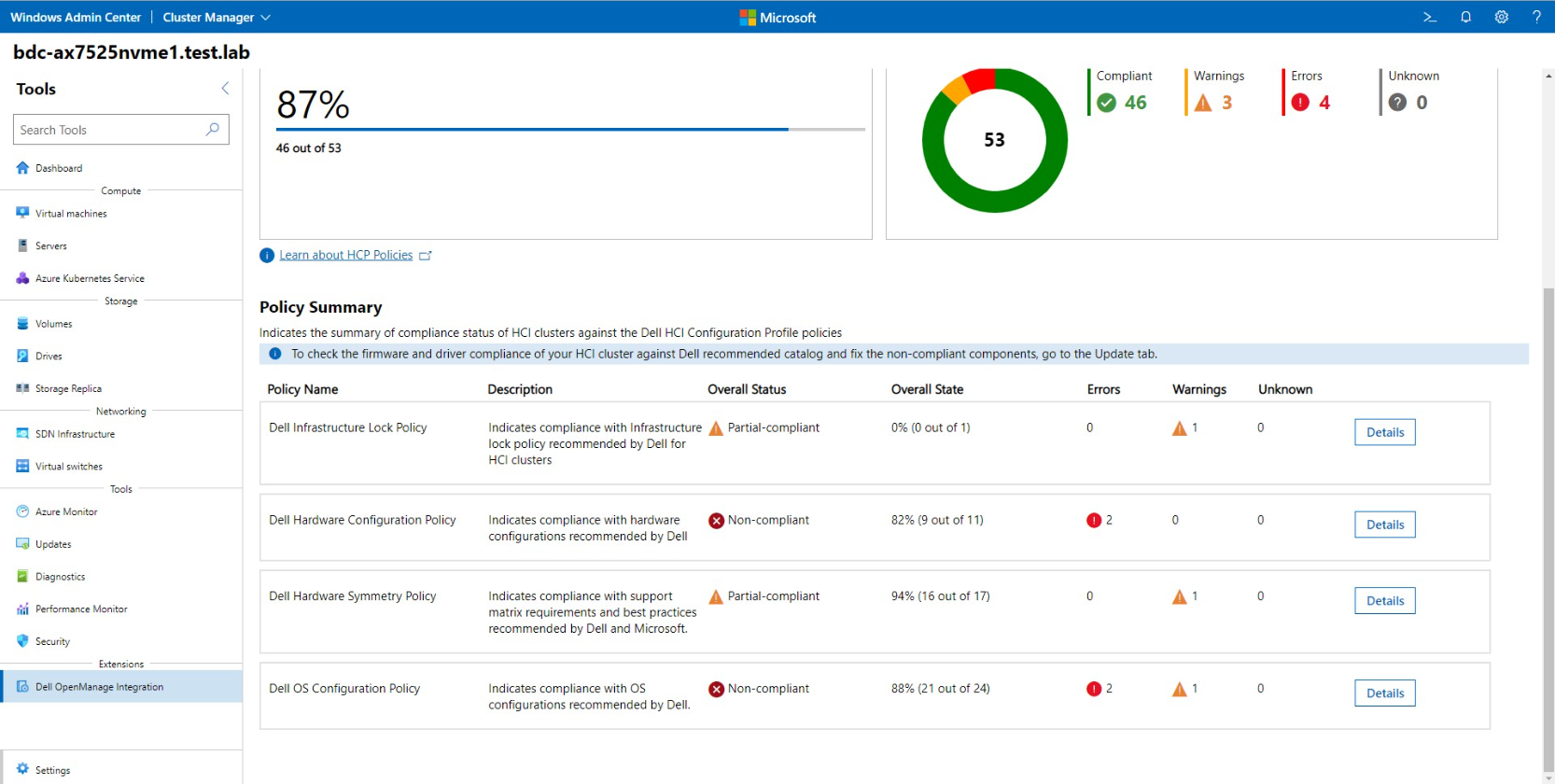
Figure 4: Dell HCP Policies for Azure - HCP Policy Summary
To re-align non-compliant policies with the best practices validated by Dell Engineering, our Dell HCP policy remediation integration with WAC (unique at the moment) helps to fix any non-compliant errors. Simply click “Fix Compliance.”

Figure 5: Dell HCP Policies for Azure - HCP policy remediation
Some fixes may require manual intervention; others can be corrected in a fully automated manner using the Cluster-Aware Updating framework.
Conclusion
The “Azure hybrid first” strategy is real today. You can use Dell HCP Policies for Azure, which provides a single-policy definition with Dell HCI Configuration Profile and a consistent hybrid management experience, whether you use Dell OMIMSWAC for local management or Azure Portal for management at-scale.
With Dell HCP Policies for Azure, policy compliance and remediation are fully covered for Azure and Azure Stack HCI hybrid environments.
You can see Dell HCP Policies for Azure in action at the interactive Dell Demo Center.
Thanks for reading!
Author: Ignacio Borrero, Dell Senior Principal Engineer CI & HCI, Technical Marketing
Twitter: @virtualpeli

Dell EMC OpenManage Integration with Microsoft Windows Admin Center v2.0 Technical Walkthrough
Wed, 16 Jun 2021 13:35:49 -0000
|Read Time: 0 minutes
Introduction
Dell EMC Integrated System for Microsoft Azure Stack HCI is a fully integrated HCI system for hybrid cloud environments that delivers a modern, cloud-like operational experience on-premises from a mature market leader.
The integrated system is based on our flexible AX nodes family as the laying foundation, and combines Dell Technologies full stack life cycle management with the Microsoft Azure Stack HCI operating system.
This blog focuses on one of the most important and critical parts of Azure Stack HCI: the management layer. Check this blog for additional background.
We will show how at Dell Technologies we make the good - Microsoft Windows Admin Center (WAC) - even better, through our OpenManage Integration with Microsoft Windows Admin Center v2.0 (OMIMSWAC).
The following diagram illustrates a typical Dell Technologies Azure Stack HCI setup:
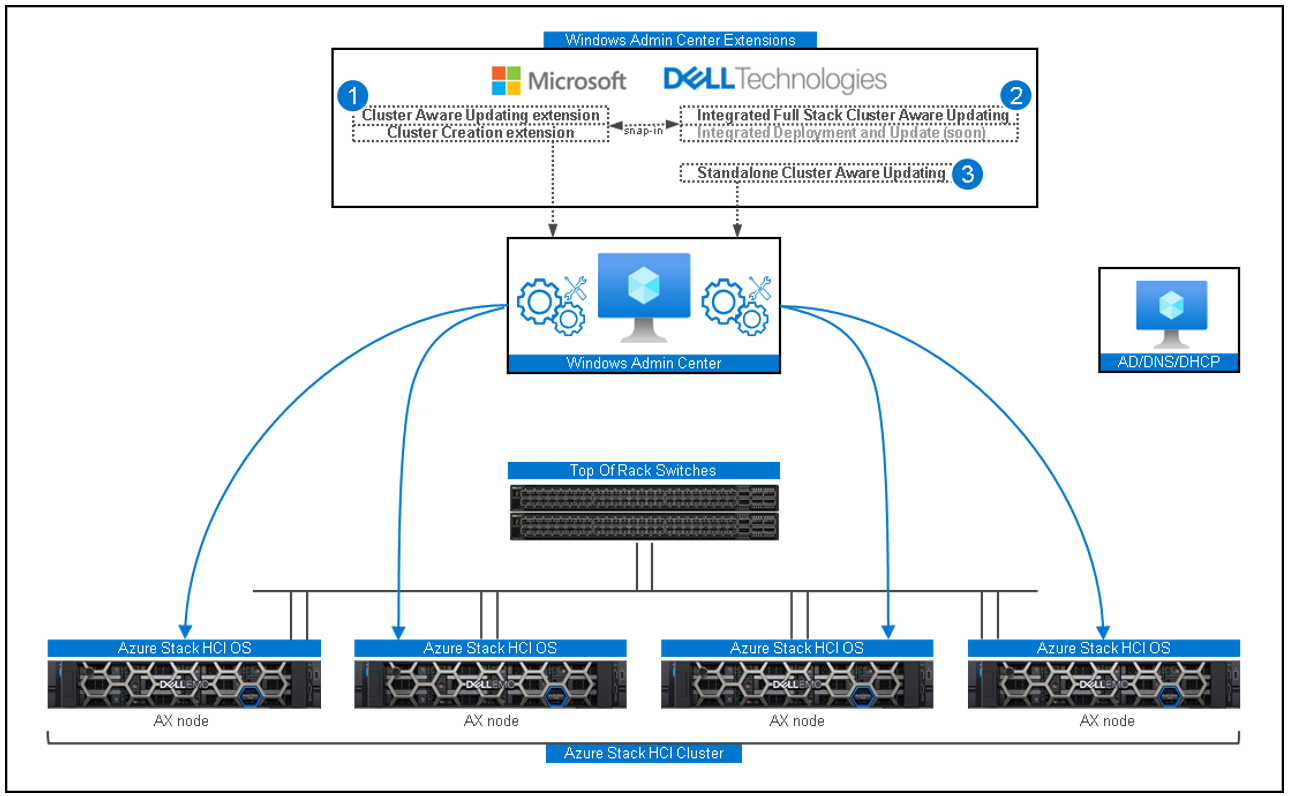
To learn more about Microsoft HCI Solutions from Dell Technologies and get details on each of the different components, check out this video where our Dell Technologies experts examine the solution thoroughly from the bottom up.
Windows Admin Center Extensions from Microsoft
WAC provides the option to leverage easy-to-use workflows to perform many tasks, including automatic deployments (coming soon) and updates.
Dell Technologies has developed specialized snap-ins that integrate OpenManage with WAC to further extend the capabilities of Microsoft’s WAC extensions.
The following table describes the three key elements highlighted in the previous diagram as (1), (2), and (3). We examine each in detail in the next three sections.
| Item | Type | Integrates with | Developed by | Description |
|---|---|---|---|---|
Microsoft Cluster Aware Updating extension Microsoft Failover Cluster Tool Extension 1.250.0.nupkg release* * Min version validated | Extension | WAC | Microsoft | WAC workflow to apply cluster aware OS updates |
Dell EMC Integrated Full Stack Cluster Aware Updating | Integration | Microsoft CAU extension | Dell Technologies | Integration snap-in to main CAU workflow to provide BIOS, firmware and driver updates while performing OS updates |
OMIMSWAC v2.0 Standalone extension | Extension | WAC | Dell Technologies | OpenManage WAC extension for Infrastructure Life cycle management, plus cluster monitoring, inventory and troubleshooting |
Cluster Creation extension Microsoft Cluster Creation Extension 1.529.0.nupkg release* * Min version validated | Extension | WAC | Microsoft | WAC workflow to create Azure Stack HCI Clusters |
Integrated Deployment and Update (coming soon) | Integration | Microsoft IDU extension | Dell Technologies | Integration snap-in to main Cluster Creation workflow to provide BIOS, firmware and driver updates during the cluster creation process |
Windows Admin Center extensions and integrations
You can install Microsoft Cluster Aware Updating extension within WAC by selecting the “Gear” icon on the top right corner, then under “Gateway”, navigate to “Extensions”. Under “Available extensions”, find the desired extension and select “Install”. For details, see the install guide. Please refer to the extensions product documentation for the latest updates.
Microsoft Cluster Aware Updating extension
To get to Microsoft WAC Azure Stack HCI Cluster Aware Updating extension, login to WAC and follow these steps:
- Click on the cluster you want to connect to. This takes us to the cluster Dashboard.
- On the left pane, under “Tools”, select “Update”.
- In the “Updates” window, click on “Check for updates”, which will pop up the “Install updates” window.
- Here we are presented with a three-step process where we select, in order:
- Operating system updates
- Hardware updates
- Proceed with the installation
It is important to note that you can select either to run only one operation at a time by skipping the other or run both in one single process and reboot.
You may select, if available, any Operating system update and click “Next: Hardware updates”. 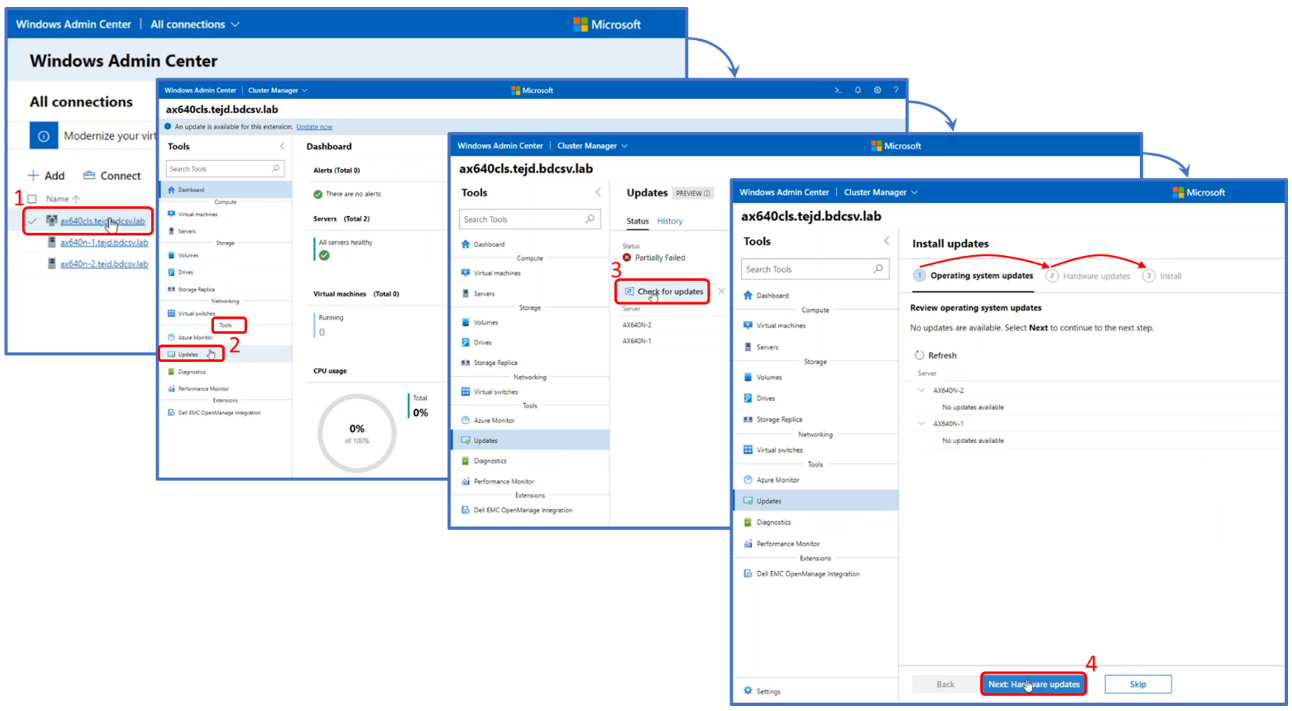
This takes us to the second step of the sequence - Hardware updates - a key phase for the automated end-to-end cluster aware update process.
This is where the Dell Technologies snap-in integrates with Microsoft’s original workflow, allowing us to seamlessly provide automated BIOS, firmware, and driver updates (and OS updates if also selected) to all the nodes in the cluster with a single reboot. Let’s look at this process in detail in the next section.
Dell EMC Integrated Full Stack Cluster Aware Updating
Once you click “Next: Hardware updates” on the original Microsoft’s Azure Stack HCI Cluster Aware Updating workflow, you are taken to Dell EMC Cluster Aware Updating integration.
If the integration is not installed, there is an option to install it from inside the workflow.
Click “Get updates”.
Our snap-in for Cluster Aware Updating (CAU) takes us through the following sequence of five steps.
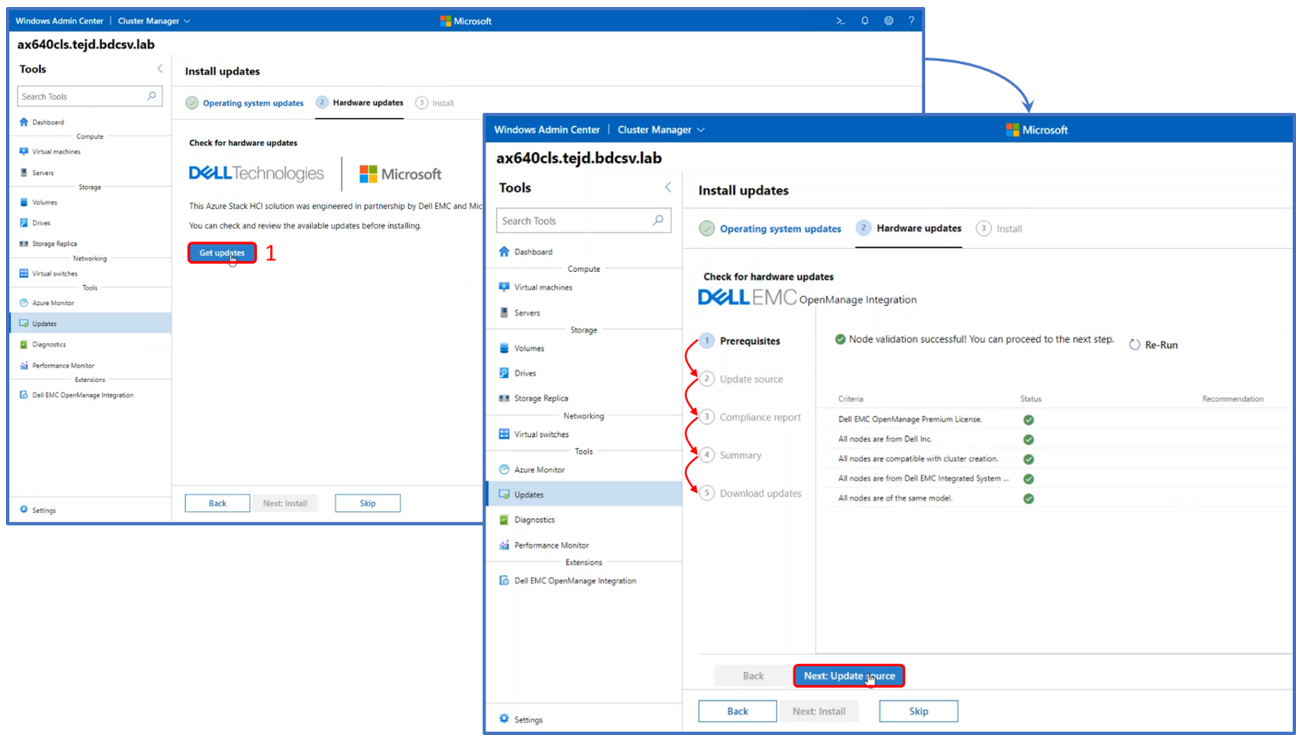
1. Prerequisites (screenshot above)
A validation process occurs, checking that all AX nodes are:
- Supported in the HCL
- Same model
- OpenManage Premium License for MSFT HCI Solutions compliant (included in AX node base solution)
- Compatible with cluster creation
Click “Next: Update source”.
2. Update source
Here we can select the source for our BIOS, firmware, and driver repository, whether online [Update Catalog for Microsoft HCI Solutions] or offline (edge or disconnected) [Dell EMC Repository Manager Catalog]. Dell Technologies has created and keeps these solution catalogs updated.
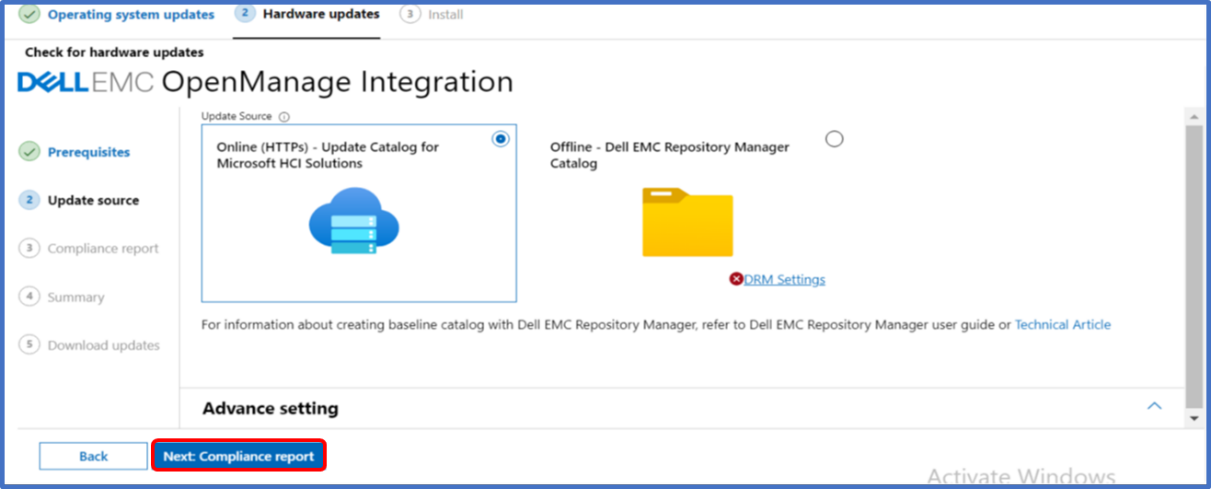
Click “Next: Compliance report”.
3. Compliance report
Now we can check how compliant our nodes are and select for BIOS, firmware, and/or driver remediation. All the recommended components are selected by default.
The compliance operation runs in parallel for all nodes, and the report is shown consolidated across nodes.
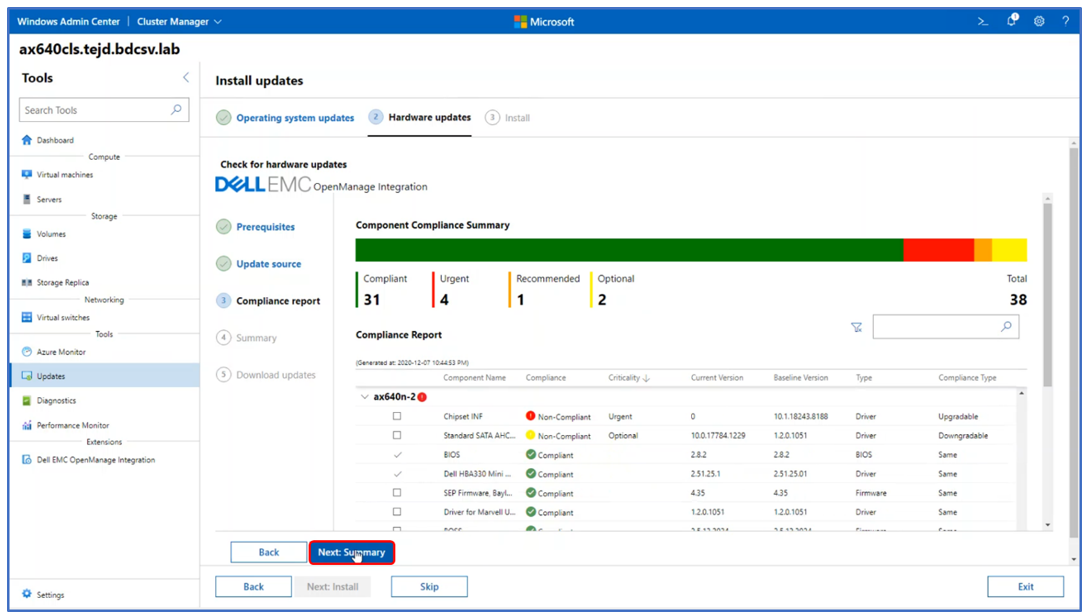
Click “Next: Summary”.
4. Summary
All selections from all nodes are shown in Summary for review before we click “Next: Download updates”.
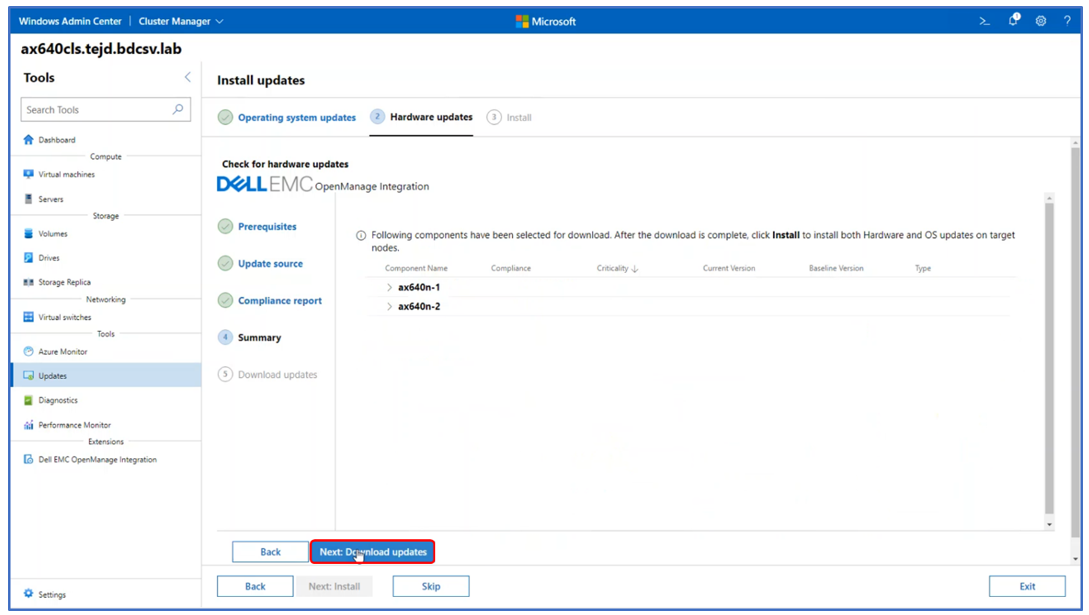
5. Download updates
This window provides the statistics regarding the download process (start time, download status).
When all downloads are completed, we can click “Next: Install”, which takes us back again to Step 3 of the main workflow (“Install”), to begin the installation process of OS and hardware updates (if both were selected) on the target nodes.
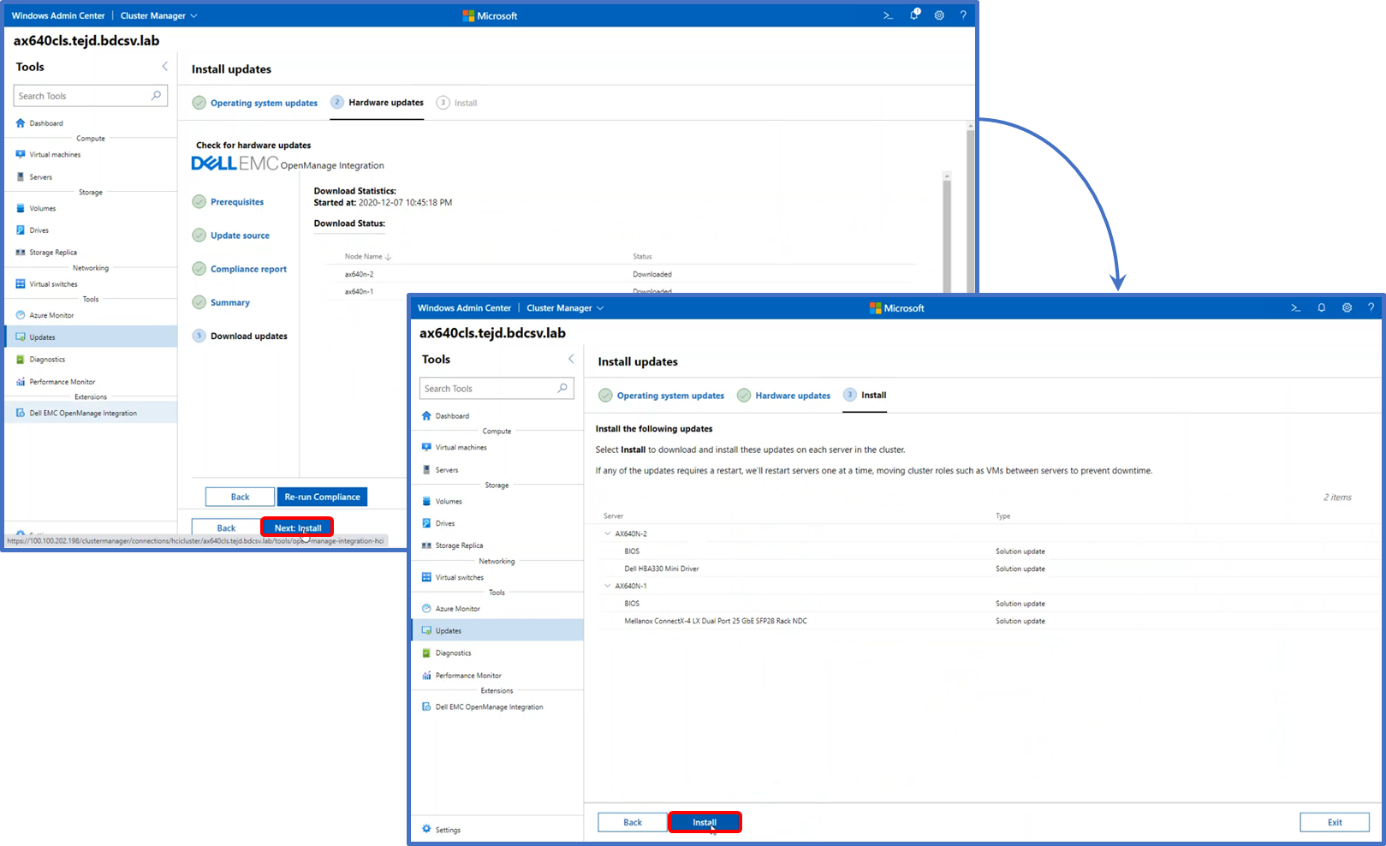
If any of the updates requires a restart, servers will be rebooted one at a time, moving cluster roles such as VMs between servers to prevent downtime and guaranteeing business continuity.
Once the process is finished for all the nodes, we can go back to “Updates” to check for the latest update status and/or Update history for previous updates.
It is important to note that the Cluster Aware Updating extension is supported only for Dell EMC Integrated System for Microsoft Azure Stack HCI.
OMIMSWAC v2.0 Standalone extension
The standalone extension applies to Windows Server HCI and Azure Stack HCI, and continues to provide monitoring, inventory, troubleshooting, and hardware updates with CAU.
New to OMIMSWAC 2.0 is the option to schedule updates during a programmed maintenance window for greater flexibility and control during the update process.
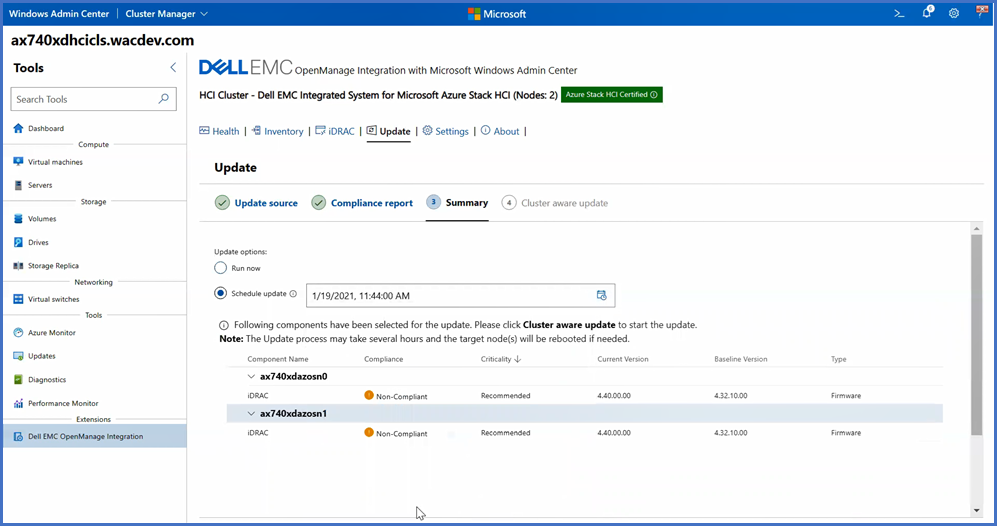
It is important to note that OMIMSWAC Standalone version provides the Cluster Aware Updating feature for the hardware (BIOS, firmware, drivers) in a single reboot, although this process is not integrated with operating system updates. It provides full lifecycle management just for the hardware, not the OS layer.
Another key takeaway is that OMIMSWAC Standalone version fully supports Dell EMC HCI Solutions from Microsoft Windows Server and even certain qualified previous solutions (Dell EMC Storage Spaces Direct Ready Nodes).
Conclusion
Dell Technologies has developed OMIMSWAC to make integrated systems’ lifecycle management a seamless and easy process. It can fully guarantee controlled end-to-end cluster hardware and software update processes during the lifespan of the service.
The Dell EMC OMIMSWAC automated and programmatic approach provides obvious benefits, like mitigating risk caused by human intervention, significantly fewer steps to update clusters, and significantly less focused attention time for IT administrators. In small 4-node cluster deployments, this can mean up to 80% fewer steps and up to 90% less focused attention from an IT operator.
Full details on the benefits of performing these operations automatically through OMIMSWAC versus doing it manually are explained in this white paper.
Thank you for reading this far and stay tuned for more blog updates in this space!





